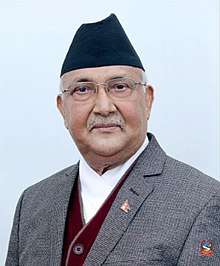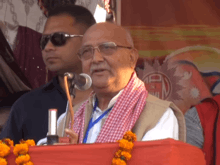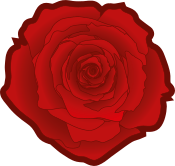Khadga Prasad Oli
| The Right Honourable Khadga Prasad Sharma Oli | |
|---|---|
| खड्ग प्रसाद ओली | |
 | |
| 38th Prime Minister of Nepal | |
|
Assumed office 15 February 2018 | |
| President | Bidhya Devi Bhandari |
| Preceded by | Sher Bahadur Deuba |
|
In office 12 October 2015 – 4 August 2016 | |
| President |
Ram Baran Yadav Bidhya Devi Bhandari |
| Preceded by | Sushil Koirala |
| Succeeded by | Pushpa Kamal Dahal |
| Chairman of the Nepal Communist Party | |
|
Assumed office 17 May 2018 | |
| Preceded by | Position established |
| Minister for Foreign Affairs | |
|
In office 2006–2007 | |
| Minister of Home Affairs | |
|
In office 1994–1995 | |
| Personal details | |
| Born |
22 February 1952 Terathum, Nepal |
| Citizenship | Nepali |
| Nationality | Nepali |
| Political party | Nepal Communist Party |
| Spouse(s) | Radhika Shakya |
| Parents | Mohan Prasad Oli, Madhumaya Oli |
| Residence | Balkot, Bhaktapur |
Khadga Prasad Sharma Oli (born 22 February 1952), more commonly known by abbreviated name K.P. Oli, is a Nepalese politician and the current Prime Minister of Nepal.[1][2][3] He is one of the two Chairmen of the Nepal Communist Party, formed by the union of Communist Party of Nepal (Unified Marxist–Leninist) and Communist Party of Nepal (Maoist Centre). Oli previously served as prime minister from 11 October 2015 to 3 August 2016 and was the first elected prime minister under the newly adopted Constitution of Nepal.[4]
Personal life

K.P. Oli was born on 22 February 1952 in a Brahmin family[5][6] at Terathum. He was the eldest child of Mohan Prasad and Madhumaya Oli. Oli was raised by his grandmother, Rammaya, after his mother died of smallpox when Oli was four.[7] He did his primary school education in Terathum and later his family migrated to the south eastern district of Jhapa. He resided mostly in Jhapa during his early political life. Oli started his studies at Himalaya Higher Secondary School in Damak municipality of Jhapa district at the age of 12. He left school in grade six.[8]
Oli met his wife, Radhika Shakya, a fellow communist, after coming out of prison. They first met in the course of party activities and married later. Kp oli current hometown is Jhapa, Nepal. [9]
Marxist insurgency years 1966–1991
Oli began his political career in 1966 in opposition to the party-less Panchayat System in place at the time. He joined the Communist Party of Nepal in February 1970. He became involved in subversive politics and was arrested for the first time in 1970. A year later he became a district committee member of the party and soon the chief of the Jhapa Movement Organizing Committee in 1972. Oli was imprisoned for 14 consecutive years from 1973 to 1987. After his release from prison in 1987, he became a central committee member of UML in-charge of the Lumbini Zone until 1990.
Multi-party democracy 1991–2006
After the 1990 People's Movement, he was elected as a member of parliament from Jhapa constituency no. 6 in 1991. He held the post of chief of the foreign department of the CPN (UML) in 1992.
He was reelected to parliament in 1994 and served as Minister of Home Affairs in Manmohan Adhikari's minority government. He was re-elected to the House of Representatives from Jhapa constituencies 2 and 6 in 1999 and gave up his Jhapa-6 seat.
Transition period
Oli was appointed as Deputy Prime Minister and Minister of Foreign Affairs as part of the interim government of Girija Prasad Koirala in 2006.[10][11] He was also assigned to look into the death of fellow politician Madan Bhandari.
Oli was defeated in the 2008 Constituent Assembly election from Jhapa-7. He also lost the election for the position of Chairman to Jhala Nath Khanal during the eight general congress of CPN-UML in 2009.
He was elected from Jhapa-7 in the 2013 Constituent Assembly election and became leader of the CPN-UML Parliamentary Party on 4 February 2014, defeating party Chairman Jhala Nath Khanal by a vote of 98 to 75.[12] Oli was subsequently elected as the Chairman of CPN-UML in July 2014 during the ninth general congress.[13][14]
First prime ministership
He was elected as Prime Minister in a parliamentary vote on 11 October 2015, receiving 338 votes out of 597. Oli's PM candidacy was supported by the UCPN-Maoist, Rastriya Prajatantra Party Nepal, and Madhesi Rights Forum-Democratic along with 13 other small parties. He was sworn in on 12 October.[15]
His first stint was dominated by the economic blockade imposed by India upon the promulgation of the Constitution of Nepal.[16] He took a defiant stance against India's position to amend the constitution and signed trade and transit treaties with China to counter Indian dependence.[17]
Following the withdrawal of support from the Communist Party of Nepal (Maoist-Centre) on 13 July 2016 from the existing coalition government and subsequent registration of a no-confidence motion by the party on 14 July 2016, CPN-UML and acting Prime Minister KP Oli seemingly shrank to a minority which pressured him to resign. But CPN-UML's decision to discuss filed no confidence motion led to a three-day parliament meeting of the concerned parties. During the process, two other major parties, Rastriya Prajatantra Party and Madhesi Rights Forum-Democratic, also removed their support from the coalition. On the third day, 24 July 2016, after addressing the opposition parties in parliament, Oli announced his resignation.
Second prime ministership
Oli was elected as Prime Minister of Nepal for second time[18] on 15 February 2018 after CPN-UML became the largest party in the House of Representatives with support from UCPN-Maoist.[19]
Electoral history
He was elected to the Pratinidhi Sabha from Jhapa in 1991, 1994 and 1999 on a CPN-UML ticket.[20] He contested and won from two constituencies in the 1999 election and gave up his Jhapa-6 seat. He lost the 2008 Constituent assembly election. Only the top two candidates are shown below.
1991 Pratinidhi Sabha Election Jhapa-6
| Party | Candidate | Votes | Status |
|---|---|---|---|
| CPN-UML | K.P. Oli | – | Elected |
1994 Pratinidhi Sabha Election Jhapa-6
| Party | Candidate | Votes | Status |
|---|---|---|---|
| CPN-UML | K.P. Oli | 18,861 | Elected |
| Nepali Congress | Keshav Kumar Budhathoki | 14,202 | Lost |
1999 Pratinidhi Sabha Election Jhapa-2
| Party | Candidate | Votes | Status |
|---|---|---|---|
| CPN-UML | K.P. Oli | 18,909 | Elected |
| Nepali Congress | Giriraj Kumari Prasai | 18,892 | Lost |
1999 Pratinidhi Sabha Election Jhapa-6
| Party | Candidate | Votes | Status |
|---|---|---|---|
| CPN-UML | K.P. Oli | 23,749 | Elected |
| Nepali Congress | Kasi Lal Tajpuriya | 19,713 | Lost |
2008 Constituent Assembly Election Jhapa-7
| Party | Candidate | Votes | Status |
|---|---|---|---|
| CPN-UML | K.P. Oli | 14,959 | Lost |
| Unified Communist Party of Nepal (Maoist) | Bishwodip Lingden Limbu | 16,099 | Elected |
2013 Constituent Assembly Election Jhapa-7
| Party | Candidate | Votes | Status |
|---|---|---|---|
| CPN-UML | K.P. Oli | 19,287 | Elected |
| Nepali Congress | Suresh Kumar Youngaya | 11,041 | Lost |
2015 Parliamentary Prime Minister Election
| Party | Candidate | Votes | Status |
|---|---|---|---|
| CPN-UML | K.P. Oli | 338 | Elected |
| Nepali Congress | Sushil Koirala | 249 | Lost |
2017 House of Representatives Election Jhapa-5[21]
| Party | Candidate | Votes | Status |
|---|---|---|---|
| CPN-UML | K.P. Sharma Oli | 57,139 | Elected |
| Nepali Congress | Khagendra Adhikari | 28,297 | Lost |
See also
References
- ↑ "Oli appointed as 41st PM of Nepal". My Republica Online. Retrieved 15 February 2018.
- ↑ "KP Sharma Oli appointed Nepal's new prime minister". www.aljazeera.com. Retrieved 2018-02-15.
- ↑ "Oli as 41st PM of Nepal – Bolchha Nepal". Bolchha Nepal. 2018-02-15. Retrieved 2018-02-15.
- ↑ "Oli I elected 38th Prime Minister of Nepal (Update)". The Kathmandu Post. Retrieved 11 October 2015.
- ↑ "The Original Maoist". Nepali Times. Retrieved 2017-12-13.
- ↑ "KP Sharma Oli-why Nepal's new PM isn't the right man for the job". catchnews.com. Retrieved 2017-12-13.
- ↑ "Read a brief biography on newly elected PM KP Sharma Oli". The Kathmandu Post. Kantipur Publications. Retrieved 8 December 2017.
- ↑ Sharma Manohar, "Oli ko Jeevani (Life of Oli)", Jana Astha National Weekly, 12th January 2004. Page 12
- ↑ "Jeevan saathi with Mr & Mrs. K.P. Oli". YouTube. Himalaya TV. Retrieved 8 December 2017.
- ↑ "Nepal calls ceasefire with rebels". BBC. 3 May 2006. Retrieved 15 July 2012.
- ↑ Moriarty, James. "Seven Cabinet Members Formed". Wikileaks. US Embassy, Kathmandu. Retrieved 21 September 2015.
- ↑ "Oli elected as UML PP leader". eKantipur. 4 February 2014. Retrieved 4 February 2014.
- ↑ "The Himalayan Times: Oli elected UML chairman mixed results in other posts – Detail News: Nepal News Portal". The Himalayan Times. 15 July 2014. Retrieved 15 July 2014.
- ↑ "Nepal congratulates Oli for election victory". Myrepublica.com. 15 July 2014. Retrieved 15 July 2014.
- ↑ "Nepal's new premier names protest group leaders as deputies", Associated Press, 12 October 2015.
- ↑ Sharma, Bhadra. "Nepal's Prime Minister, K. P. Sharma Oli, Resigns Ahead of a No-Confidence Vote". The New York Times. Retrieved 16 February 2018.
- ↑ "Oli once more". Nepali Times. Himal Media Pvt Ltd. Retrieved 17 February 2018.
- ↑ "KP Oli becomes Prime Minister of Nepal for the second time". Kathmandu Tribune. Nepal Tribune Media. Retrieved 6 March 2018.
- ↑ Sharma, Gopal. "Moderate Nepali communist Oli to 'balance China, India' as new PM". Reuters. Thomson Reuters. Retrieved 16 February 2018.
- ↑ Election Commission of Nepal Archived 12 October 2006 at the Wayback Machine.
- ↑ "Jhapa : Province 1 – Nepal Election Latest Updates and Result for Federal Parliament". The Kathmandu Post. Retrieved 10 December 2017.
External links
| Party political offices | ||
|---|---|---|
| Preceded by Jhala Nath Khanal |
Leader of the Communist Party-Unified Marxist/Leninist 2014–present |
Succeeded by -- |
| Preceded by -- |
Leader of the Nepal Communist Party 2018–present |
Incumbent |
| Political offices | ||
| Preceded by Sushil Koirala |
Prime Minister of Nepal 2015–2016 |
Succeeded by Pushpa Kamal Dahal |
| Preceded by Sher Bahadur Deuba |
Prime Minister of Nepal 2018–present |
Incumbent |

